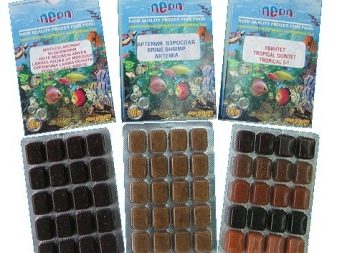The nutrition of aquarium fish should be full and varied. This is the key to strong immunity, good growth and effective reproduction of aquatic inhabitants. Therefore, fresh-frozen feeds have gained particular popularity among aquarists. With such food, fish get the necessary proteins, fats and carbohydrates.
Features
Initially, there were exclusively live feeds, then in addition to them came dry and frozen, with the last of which holding the palm among aquarists for more than half a century. Such feeds are easier to store, while they are guaranteed safer from infection with a variety of helminths and bacteria. Huge consumer appeal is due to their natural origin, preserving all the nutritional value and essential amino acids. In addition, frozen food for aquarium fish is enriched with necessary vitamins and minerals, which are so important for the body of aquatic inhabitants.
The idea of keeping domestic fish belongs to the Chinese. The first was crucian carp, which was specially selected with birth defects and malformations (bulging eyes, bifurcated tails, missing fins). This is a familiar goldfish to all of us. In the Russian Empire, the first decorative fish appeared in the XV century. Europe first saw them only in the 17th century. For Europeans, such an unusual pet was very expensive. They died in large numbers due to the popular belief that such unusual creatures feed only on “ether” and they don’t need any other food at all.
Only with time did people become convinced that aquarium fish still needed a variety of organic foods.



What is related?
The main task of the aquarist is to create the closest possible living conditions to the natural environment. At the same time, properly selected shock freezing food allows you to get as close to the natural food base as possible. The main advantage of such nutrition: is as follows:
- natural appearance;
- the composition is easily absorbed;
- optimal ratio of vitamins, minerals, natural dyes.
They are made in the form of rectangular briquettes or cubes resembling a bar of chocolate. This form is more practical to use. It is stored for three months. A large number of fish eat food with great pleasure, such as:
- bloodworm;
- coretre;
- pipe maker;
- Cyclops;
- daphnia;
- Artemia
- hamarus;
- wolfia;
- mollusks;
- larvae;
- Worms
- meat of shrimp, squid, fish;
- with spinach or spirulina.
In pet stores you can find feed of the same species or mixed, collected according to the principle of species feeding. And also food is provided by age (for large fish or fry). Before buying this or that frozen food for aquarium fish, carefully read the composition and expiration date.


Proper defrosting
Proper defrosting of food is the key to the successful preservation of all nutrients. Break off a small piece from the briquette, place in a small container, rinsing with running water until completely defrosted. It is impossible to give food that has not completely thawed, as ice crystals can damage the stomach and intestines of fish. It should be fed in small portions using a measuring spoon or tweezers. It is important not to throw frozen food into the aquarium. Excess uneaten and meltwater will result in clouding of the water and fish disease.
Important! Defrost as much feed as fish can eat at a time. Repeated freezing greatly affects quality, significantly reducing its nutritional value.


You can cook ice cream on your own. For this, you should use any live food, except for the tubule. It is likely to contain harmful substances. The procedure is simple. Rinse everything thoroughly, place in ice containers, pour a small amount of water, close the lid and place in the freezer.
However, do not get carried away with this method. Manufacturers use shock freezing, which can not damage the delicate flesh of organisms. Damaged ones lose most of their nutrients and trace elements.


We determine the quality
Get frozen food in the form of chocolate. This form has the following advantages for small aquariums:
- convenient to use - break off as many briquettes as necessary for one feeding;
- this form does not tolerate constant defrosting and freezing; if the appearance is correct, not deformed, then the feed during transportation and storage was not thawed.
Packaging only protects against moisture. When oxygen enters, the contents undergo an oxidation process. Toxic substances begin to form in the frozen product, which have a negative effect on the health of the fish. And visually evaluate the quality of the feed. Each larva, each piece should be clearly visible. Refuse to purchase if everything is poorly distinguishable.
The best option is vacuum packaging. The container consists of 5 layers of barrier film, complementing each other. As a result, the product does not oxidize and does not undergo the development of pathogenic microorganisms and putrefactive fungi. And also the shelf life of such feed is twice as long as that of the rest of the frozen representatives.


Manufacturers Overview
Barrom (Russia)
In 1992, the company began its existence, specializing in the procurement of artemia cysts, gammarus and other bio-feed.Finished products undergo rigorous laboratory quality control and veterinary safety checks. All products offered by the company comply with international standards.

Aquaria (Ukraine)
It was founded in 2001, making the main focus on the production of frozen food in blister packs. For production, only natural raw materials are used. Ready meals undergo thorough veterinary control. All mixtures are developed taking into account the needs of each type of aquarium fish. Products are disinfected with ozone.

Katrinex (Poland)
The company began operations in 1992, successfully providing the market with the best traditional live products for aquariums. Field of production - frozen food in the form of blisters by shock freezing method, consisting of 100% natural ingredients.


Ruto (Holland)
The company produces fish food from fresh ingredients such as fish, turkey heart, mosquito larvae, mollusks and plankton. The catch is immediately frozen and packaged in convenient portioned bags. This process allows you to create fish food without the unpleasant odor inherent in live food.


About the rules of choice and the features of feeding frozen food, see below.










